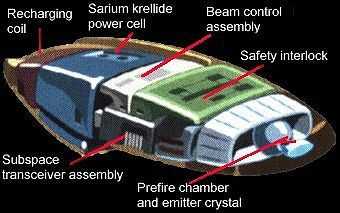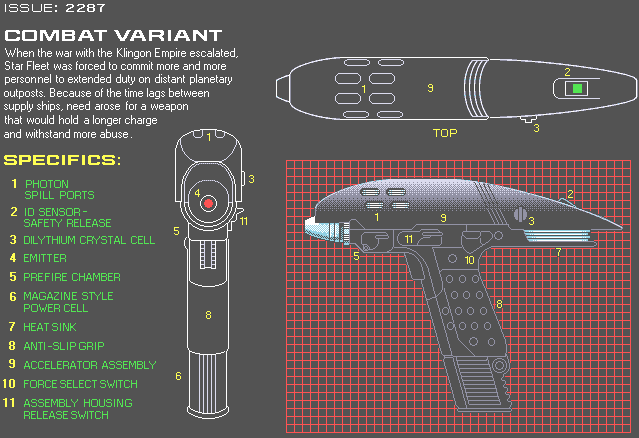Phaser energy is released by the rapid nadion effect. Rapid nadions are short-lived subatomic particles, which can liberate and transfer strong nuclear forces within a class of crystals called Fushigi-no-umi.
Phasers have three distinct effects on the target. At low power settings - setting 1 to 3 on a hand phaser - the impact of phaser energy is almost wholly limited to simple electromagnetic and mild thermal effects. These are concentrated on the nervous system of the target, causing pain and/or unconsciousness in most beings. At higher levels the thermal effect becomes prevalent, and the phaser will begin to cause physical damage to the target resulting in moderate or severe injuries. By the time the power level is at setting 7 the energy is distributed equally between thermal and nuclear disruption energy. Disruption effects become widespread, resulting in immediate death to most Humanoid life forms.
At levels higher than 7 the majority of phaser energy is in the form of nuclear disruption. A large portion of the target is simultaneously vaporized and transitioned out of the continuum, a process that is instantly fatal. The higher power settings available with Type 3 phasers (setting 9+) cause severe damage over a wide area. These settings are rarely used because of the relatively high power consumption; a single setting 10 discharge uses more than twenty five times as much energy as a setting 7 discharge, while a setting 16 discharge uses over three hundred and fifteen times as much.
Starfleet has used many models of phaser over the years, but all fall into distinct Types. Each of which represents a general classification of the energy the weapon is capable of releasing. The type of a phaser apparently does NOT refer to or limit its rate of fire or other factors.
Most
smaller phaser weapons are deployed in single emitters, also known as a
'phaser bank'.
Larger
and more modern weapons group many emitters into linear arrays. These use
force coupling to allow the energy of one emitter to be transferred almost
instantly to another - a process that can be repeated along arrays of almost
limitless size. This confers many major advantages: it allows a large group
of emitters to discharge their combined energy from any single emitter
in the array. This allows longer sustained beams to be fired, and greatly
reduces the recharge and cooling time since the energy is spread over many
emitters. In addition, redundant feeds to small groups of emitters within
the array increase the systems resistance to battle damage since destroying
part of the array will not disable the remaining emitters. A long array
can also bring the whole firepower of every emitter to bear within one
single beam - a vessel equipped with many separate phaser banks must combine
separate beams to accomplish this, something which the firing arcs of the
weapons may not allow.
.

The
diagram shows the features that are common to all types of phaser. Energy
is stored in a sarium krellide cell. Sarium krellide stores a maximum of
1.3x10^6 mega joules per cubic centimeter. Downstream from the power cell
are three interconnected control modules: the beam control assembly, safety
interlock and the subspace transceiver assembly (STA). The beam control
assembly includes the controls that alter the beam width and intensity
and the trigger. The safety interlock is used to identify and check the
person using the phaser. The STA is used as part of the safety system whilst
on a federation starship. It makes sure that power levels are automatically
restrained during firings on a starship, usually no more than heavy stun.
The STA on phasers has additional target sensors and processors for distant
aiming functions. Energy from the power cell passes through all three modules
and is then routed through shielded conduits to the prefire chamber, a
sphere of LiCu 521 1.5 cm in diameter which is reinforced with gulium arkenide.
The energy is stored temporarily by a charge barrier. When this charge
barrier collapses the energy is discharged through the LiCu emitter crystal
as a pulse of energy.
Upon
firing the charge barrier breaks down in 0.02 picoseconds. Through the
rapid nadion effect the LiCu 521 emitter converts this pulse into a tuned
phaser discharge. As with the ships main phaser banks the more energy in
the prefire chamber, the greater the percentage of nuclear disruption.
At low to moderate settings the nuclear disruption threshold isn't crossed,
limiting the phaser discharge to stun and thermal effects (resulting from
electromagnetic effects).
.
| 1.
Light Stun
Knocks out base-type humanoids for up to five minutes. |
9.
Disruption effects
Damage to heavy alloy and ceramic materials over 100cm thick. |
| 2.
Medium Stun
Knocks out base-type humanoids for up to 15 minutes. |
10.
Disruption effects
Heavy alloy and ceramic over 100cm thick are vaporized. |
| 3.
Heavy Stun
Knocks out base-type humanoids for up to 1 Hour. |
11.
Disruption/explosive effects
Ultra dense alloy materials Light geological displacement. |
| 4.
Thermal effects
Causes neural damage and skin burns to base-type humanoids. |
12.
Disruption/explosive effects
Ultra dense alloy materials vaporize. Medium geological displacement. |
| 5.
Thermal effects
Causes severe burn effects to humanoid tissue. |
13.
Disruption/explosive effects
Light vibrations to shielded matter. Medium geological displacement. |
| 6.
Disruption effects
Causes matter to disassociate and deeply penetrates organic tissue. |
14.
Disruption/explosive effects
Medium vibrations to shielded matter. Heavy geological displacement. |
| 7.
Disruption effects
Kills humanoids as disruption effects becomes widespread. |
15.
Disruption/explosive effects
Major vibrations to shielded matter. Heavy geological displacement. |
| 8.
Disruption effects
Cascading disruption forces vaporizes humanoid organisms.Maximum setting for type I phasers. |
16.
Disruption/explosive effects
Shielded matter fractures. Heavy geological displacement. Maximum setting for type II phasers. |
This
is a larger hand unit. Early models of the type 2 phaser used a type 1
phaser clipped into a pistol grip, but modern weapons seem to have little
in common with the smaller model. The modern type 2 phaser can fire up
to setting 16, which causes the destruction of some 3,900 metric tons of
rock per 0.28 second discharge.









The Compression rifle concentrated on simplicity. The LiCu 521 discharge crystal was doped with arsenic atoms and trisilinate molecules in order to restrict the phaser energy discharge. The doping materials diverted a small part of the discharging energy to re-establish the charge barrier between the discharge crystal and the Sarium kelleride power crystal, limiting or compressing the beam to a maximum of 200 picoseconds of firing. This would fire the entire energy discharge in a beam of only 6 centimeters length, greatly increasing the intensity of the energy and so enhancing the effect on the target.
Although it was by far the simpler of the two weapons, great difficulties were encountered during the development of the compression rifle. Most of these centered around thermal damage to the discharge crystal resulting from the very high energy intensities flowing through it. Average firing lifetime of an emitter crystal in the first model developed was only 9.6 nanoseconds - 48 discharges - a far from acceptable figure. Redesign of the shape of the emitter boosted this figure to 28 nanoseconds, still not sufficient for a field weapon. The solution arrived at was to install two high capacity cooling systems, one mounted on either side of the rifle. This boosted the emitter crystals lifetime to 600 nanoseconds, or 3,000 discharges. Starfleet deemed this just about acceptable and rushed the compression rifle into limited service.
The
weapon was never satisfactory - although the cooling systems worked reasonably
well they made the weapon heavy and difficult to use properly at long ranges.
The emitter crystal was also rather sensitive to adverse environmental
conditions, and if not treated carefully cracking could occur - a breakdown,
which would lead to a thermal explosion on the next discharge. Although
it was issued to some ground forces units and to the four units of the
Intrepid class Starship then in service, several thermal explosion accidents
forced Starfleet to withdraw the compression rifle in late 2373. None now
remain in use.
.
 .
.
The heavy rifle also includes a much more effective and elaborate targeting system, a more powerful gyrostabilizer, and a larger energy reserve. The rifle can fire to a maximum of Setting 18.
The
targeting unit is now being retrofitted into earlier models of phaser rifle.
The first model of heavy phaser rifle had a duranium alloy metal stiffening
to the barrel, but in service this has proved to be unnecessary and a subsequent
model was issued without this feature.
.


With the development of the USS Defiant, the pulse phaser cannon was finally reintroduced to Starfleet. Defiant is a warship, pure and simple; her designers had no real interest in conducting experiments and the attitude towards the level of lethality of her armament could perhaps best be summed up by the phrase 'take no prisoners'! Defiant's main armament comprises four heavy pulse cannon, which fire very tightly confined bursts of phaser energy for maximum impact on shielding systems. High overall energy delivered over a very short period combines with a high firing rate to produce a performance against modern shield systems which can best be described as devastating.
On
her first active mission the Defiant faced a group of Dominion Attack Ships;
these vessels had successfully withstood several minutes of fire fighting
with a Galaxy class starship, but Defiant's phaser cannon cut through their
shields within moments. Subsequent combat experience has shown the value
of this weapons system, which is currently being developed for use in other
vessels.